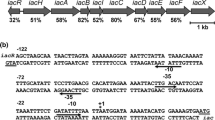Abstract.
The jlbA (jun-like bZIP) gene of Aspergillus nidulans was isolated. The deduced amino acid motif of the C-terminal region of jlbA encodes a putative DNA-binding site composed of a basic amino acid domain and an adjacent leucine zipper motif. This region shares highest similarities to the C-terminal DNA-binding domain and the basic zipper (bZIP)-motifs of transcription factors like CPCA from A. niger, Gcn4p from Saccharomyces cerevisiae, human JUNB and c-JUN. The putative jlbA protein contains a PEST-rich region (an instability region rich in the amino acids proline, glutamic acid, serine and threonine) described to be implicated in protein stability. The jlbA mRNA formation is elevated up to 40-fold upon amino acid starvation induced by the addition of the false feedback inhibitor 3-amino-1,2,4-triazole. This induction is partially dependent and partially independent on the presence of the transcription factor CPCA. Therefore jlbA is a novel gene of A. nidulans which is transcriptionally activated by amino acid starvation conditions.
Similar content being viewed by others
Author information
Authors and Affiliations
Additional information
Electronic Publication
Rights and permissions
About this article
Cite this article
Strittmatter, A.W., Irniger, S. & Braus, G.H. Induction of jlbA mRNA synthesis for a putative bZIP protein of Aspergillus nidulans by amino acid starvation. Curr Genet 39, 327–334 (2001). https://doi.org/10.1007/s002940100215
Received:
Accepted:
Issue Date:
DOI: https://doi.org/10.1007/s002940100215




